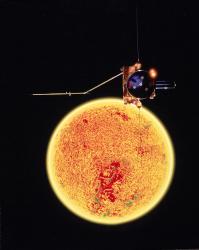 Our Sun is very close to the calmest point of its 11-year cycle of activity, what scientists call the “Solar Minimum”. But that doesn’t mean it’s totally quiet. In mid-December, NASA/ESA’s Ulysses spacecraft encountered a torrent of particles bursting from the Sun’s southern pole.
Our Sun is very close to the calmest point of its 11-year cycle of activity, what scientists call the “Solar Minimum”. But that doesn’t mean it’s totally quiet. In mid-December, NASA/ESA’s Ulysses spacecraft encountered a torrent of particles bursting from the Sun’s southern pole.
This is the third time Ulysses has passed over the Sun’s southern pole; the previous years were 1994 and 2000. But in this latest pass, the Sun is supposed to be in its solar minimum, where sunspot and flare activities are at their lowest. Satellites and observers here on Earth saw plenty of activity around the Sun’s equator, but the surprise is that Ulysses saw activity too – intense bursts of particles coming from the pole.
During Ulysses’ previous passes, the Sun was in its solar maximum, so it wasn’t a surprise to see activity above the pole. But to see activity during the solar minimum was quite unexpected. Scientists hope to get to an answer during this southern pole flyby.
Original Source: ESA News Release
